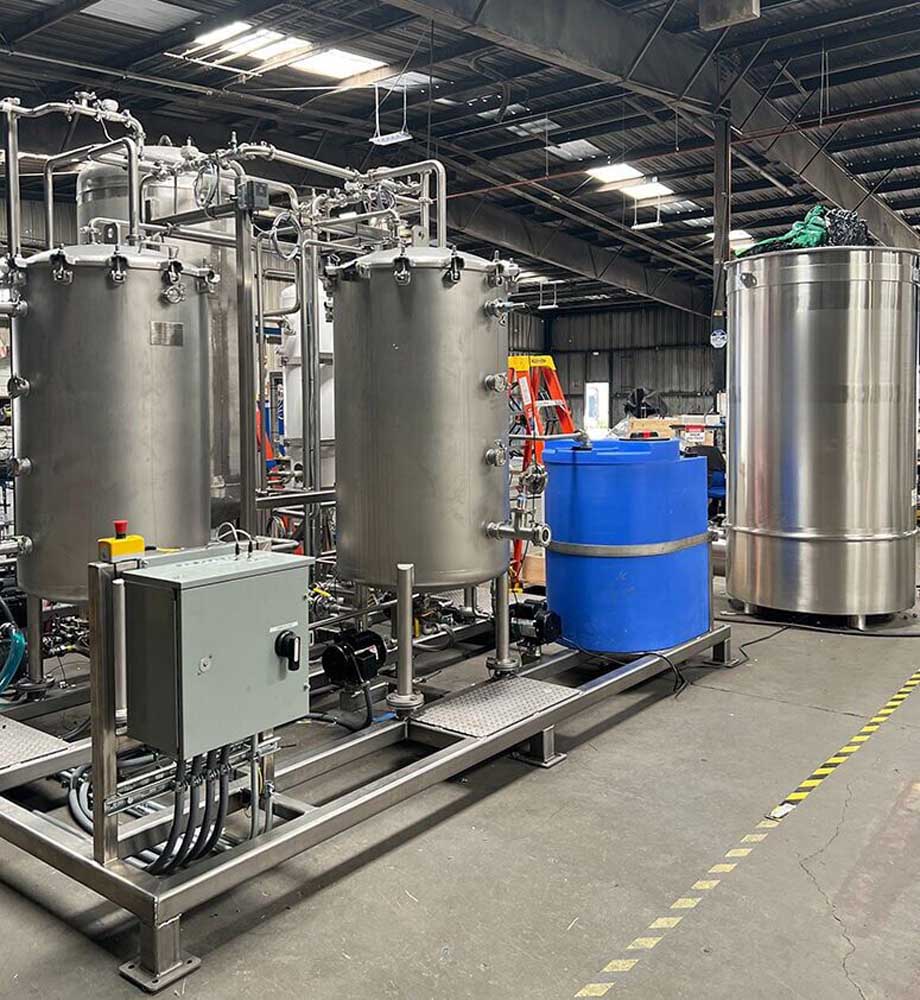Lightning in a bottle: Company making fertilizer from air, water, electricity
Published 6:00 am Sunday, April 28, 2024

- Some of Nitricity’s equipment at its headquarters in Fremont, Calif.
Today, nitrogen fertilizer is made in fossil fuel-fired factories that can be thousands of miles from the nearest farms, but one California company is working on a game-changer. It produces fertilizer using solar power and air instead of natural gas.
The company, San Francisco-based Nitricity, uses solar energy to produce “lightning” that splits nitrogen molecules from the air, just as Mother Nature does during thunderstorms.
The nitrogen in turn reacts with oxygen and water to form nitric acid. Limestone is then added to make calcium nitrate, a fertilizer that can be injected into irrigation systems.
The technology has operated successfully in multiple field trials, and now the company is focused on scaling it up, said Nicolas Pinkowski, Nitricity’s co-founder and CEO.
Stanford connection
Pinkowski and cofounders Joshua McEnaney and Jay Schwalbe started the company in 2018. The three met at Stanford University, where they were Ph.D. students and post-doctoral researchers working with nitrogen in a laboratory. Nitrogen is one of the most abundant elements on earth. It makes up about 78% of the atmosphere.
“One of our big breakthroughs in the early days was when we gave a big presentation … down in Fresno to a group of farmers and other people working on different innovations,” Pinkowski said. “And someone who runs a farm and research group in Fresno stood up in the back of the room and essentially said, ‘I want one, and I’ll pay for it.’”
That person was Charles Hillyer, director of the Center for Irrigation Technology at California State University-Fresno.
He wanted to do solar-powered fertilizer production on his farm and had a budget of $10,000 to $20,000, he said.
“That was just amazing. … I mean we’re grad students, so that’s just an incalculable sum of money,” he said.
Nitricity participated in the university’s Valley Ventures business accelerator program, and the proposal was interesting, Hillyer said.
He was a little skeptical of their process, not knowing if they knew what they were doing. But they were Ph.D. students, he said.
“We found out later they definitely knew what they were doing,” he said. “I think everyone who got involved thought this could be a real game-changer, and they caught a lot of people’s attention.”
A big part of the carbon footprint in agriculture comes from fertilizer production, transportation and application, and the way they produced fertilizer was 100% carbon-neutral, he said.
Backyard build
The Stanford trio had been working on devices connected to solar panels. They crunched the numbers on the cost of equipment and decided to take the Fresno project. They built the technology in McEnaney’s backyard, put it in a truck and drove it to Fresno.
“The plan was install it and then have a celebratory lunch at noon,” Pinkowski said.
But by 11 a.m., it was clear that wasn’t going to happen. After three months, they finally got the system to run at full capacity, he said.
The research plot was only a fraction of an acre. But the on-site, solar-powered system was successful in making fertilizer and injecting it into the irrigation system.
“It was a whole lot of effort for … a little fertilizer, but it proved the concept,” he said.
Innovative circles
The great thing was the community rallied behind the project, from Fresno State students working part-time to groups supportive of startups and innovation. It opened the door to innovative circles, investments and grants.
Hillyer “gave us a really big opportunity,” Pinkowski said.
Nitricity decommissioned the project after 14 months to focus on building bigger projects, and the company has steadily grown over the years.
With more people and more experience on the team, the company is building larger, more advanced equipment. It recently moved to a 22,000-square-foot manufacturing facility in Fremont.
Humble beginnings
Nitricity’s first plasma reactor, which creates the “lightning,” was built using a mason jar and materials found at a local hardware store, and it worked well. The company has developed several prototypes since, with dozens of iterations along the way, Pinkowski said.
“We’re very much the type of group who just likes to build it and test it and then improve what we can quickly,” he said.
“The design has evolved a lot over time,” he said.
Nitricity’s newest and largest pilot system is capable of production rates five times greater than previous prototypes. It is being used to fertilize half of a 25-acre test orchard of almond trees in Chowchilla, Calif., in partnership with Olam Food Ingredients, Elemental Excelerator and the Madera-Chowchilla Resource Conservation District.
While the company remains focused on local, solar-powered fertilizer production, it has shifted away from individual on-farm systems.
Farmer support
“Our first projects were directly on farms, and today we’re hoping to build a little bit bigger projects that actually have permanently stationed staff,” he said.
The benefit is twofold. The company is hoping those projects create local jobs, and someone would always be around to help the farmers and make sure the equipment is running smoothly, he said.
The first project will probably supply three or four farms with fertilizer, with perhaps bigger projects in the future, he said.
Nitricity’s calcium nitrate is a standard commercial fertilizer. But unlike most nitrogen fertilizers, it doesn’t require ammonia made using hydrogen from natural gas.
Solar power is the key, Pinkowski said.
The cost of production “is very closely tied to the cost of our electricity that we use to make the product. That’s because that’s our feedstock,” he said.
With affordable renewable energy prices, the company’s fertilizers can be cost competitive, he said.
“We need cheap electricity, which isn’t available everywhere, but it is certainly available in some places. That’s where we’re going to start and over time, there’ll be more opportunity,” he said.
Broader horizons
In addition to its plasma process, the company has developed other new technologies for fertilizer production. It’s premature to talk about those yet, but they are fundamentally different than the original process, he said.
“We started out with a plasma process to make nitric acid and calcium nitrate. But we have some new fertilizer products coming out that use different technologies. It’s still solar-powered,” Pinkowski said.
One he’s most excited about involves a process that blends in almond shells. The company will be announcing more on that this summer, he said.
“We don’t just use this … one technology anymore. And that one by far is the most technologically mature, but we have these other processes and fertilizers as well,” he said.
Market interest in those processes and products is high. A year from now, the company will probably have one or two new products using different processes, he said.
“We’re no longer a company just defined by our lightning in a bottle,” Pinkowski said.
Solar power
While each of the company’s processes is different, all are solar-powered. That’s in keeping with Nitricity’s mission to make good-for-the-soil fertilizers locally with renewable power rather than fossil fuels.
The advantage of Nitricity’s flagship product isn’t so much in the fertilizer and technology, it’s more the method of how it’s made — solar power rather than fossil fuels — and that it’s produced locally instead of overseas, he said.
“It not only reduces emissions but I think it can have some really profound impacts on food security. If we’re producing all the fertilizers around the world closer to where they’re needed, we can always have those fertilizers available,” he said.
That would make the food system more resilient and better protected from shocks in the system, he said.
“Then also … we can focus more on the needs of the communities and the needs of local soils rather than what’s cheapest and easiest to ship,” he said.
Nitricity’s lightning approach to fertilizer solves a number of pain points for society and farmers alike, said cofounder McEnaney.
“We can not only mitigate vast global greenhouse gas emissions from fertilizer through electrification and producing the right form of fertilizer, but also increase local fertilizer production and jobs, increase food and supply chain security and provide farmers with more options to get nutrients to their crops,” he said.
Reduced emissions
Nitricity shifts the production of fertilizers away from fossil fuels and toward renewable power, Pinkowski said.
The technology avoids most of the greenhouse gas emissions from production, distribution and application of traditional fertilizers, he said.
“It has been really exciting to find the areas where we can apply our skills to help make agriculture more sustainable and offer better solutions to farmers. It is an area that does not get the attention it deserves,” said cofounder Schwalbe.
The company collaborated with the International Fertilizer Development Center, based in Alabama, to measure the greenhouse gas emissions of its calcium nitrate fertilizer after field application compared to urea. Nitricity’s fertilizers emitted far less emissions than urea in two different soil types, he said.
Since that first pilot project in Fresno in 2020, Nitricity has presented its technology at the World Agri-Tech Innovation Summit and the UN Climate Change Conference of the Parties (COP27) in Egypt.
To date, Nitricity has raised more than $30 million in venture capital and grants. That financial support has helped the company grow and attract new talent and formalize and scale up technology, Pinkowski saidw.
Nature’s fertilizer
— Lightning breaks the triple bond of atmospheric nitrogen, or dinitrogen (N2), into nitrogen oxide (NO) and nitrogen dioxide (NO2).
— The nitrogen oxide (NO) combines with oxygen to form nitrogen dioxide (N02).
— The nitrogen dioxide (NO2) reacts with water droplets in clouds to create nitric acid (NO3).
— The nitric acid falls to the ground in rain and forms nitrates when it combines with minerals in the soil.



